
An effects unit or effects pedal is an electronic device that alters the sound of a musical instrument or other audio source through audio signal processing.

In music performances, rhythm guitar is a technique and role that performs a combination of two functions: to provide all or part of the rhythmic pulse in conjunction with other instruments from the rhythm section ; and to provide all or part of the harmony, i.e. the chords from a song's chord progression, where a chord is a group of notes played together. Therefore, the basic technique of rhythm guitar is to hold down a series of chords with the fretting hand while strumming or fingerpicking rhythmically with the other hand. More developed rhythm techniques include arpeggios, damping, riffs, chord solos, and complex strums.
In music, tremolo, or tremolando, is a trembling effect. There are two types of tremolo: either a rapid repetition of a note, or a variation in volume.
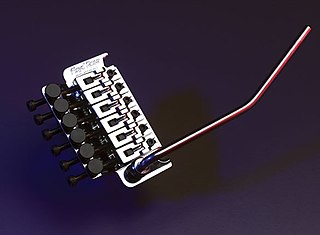
The Floyd Rose Locking Tremolo, or simply Floyd Rose, is a type of locking vibrato arm for a guitar. Floyd D. Rose invented the locking vibrato in 1976, the first of its kind, and it is now manufactured by a company of the same name. The Floyd Rose gained popularity in the 1980s through guitarists like Eddie Van Halen, Neal Schon, Brad Gillis, Joe Satriani, Steve Vai, and Alex Lifeson, who used its ability to stay in tune even with extreme changes in pitch. Its tuning stability comes through the double-locking design that has been widely regarded as revolutionary; the design has been listed on Guitar World's "10 Most Earth Shaking Guitar Innovations" and Guitar Player's "101 Greatest Moments in Guitar History 1979–1983."

Tapping is a playing technique that can be used on any stringed instrument, but which is most commonly used on guitar. The technique involves a string being fretted and set into vibration as part of a single motion. This is in contrast to standard techniques that involve fretting with one hand and picking with the other. Tapping is the primary technique intended for instruments such as the Chapman Stick.
Lead guitar is a musical part for a guitar in which the guitarist plays melody lines, instrumental fill passages, guitar solos, and occasionally, some riffs and chords within a song structure. The lead is the featured guitar, which usually plays single-note-based lines or double-stops. In rock, heavy metal, blues, jazz, punk, fusion, some pop, and other music styles, lead guitar lines are usually supported by a second guitarist who plays rhythm guitar, which consists of accompaniment chords and riffs.

Fingerstyle guitar is the technique of playing the guitar or bass guitar by plucking the strings directly with the fingertips, fingernails, or picks attached to fingers, as opposed to flatpicking. The term "fingerstyle" is something of a misnomer, since it is present in several different genres and styles of music—but mostly, because it involves a completely different technique, not just a "style" of playing, especially for the guitarist's picking/plucking hand. The term is often used synonymously with fingerpicking except in classical guitar circles, although fingerpicking can also refer to a specific tradition of folk, blues and country guitar playing in the US. The terms "fingerstyle" and "fingerpicking" are also applied to similar string instruments such as the banjo.
A vibrato system on a guitar is a mechanical device used to temporarily change the pitch of the strings. They add vibrato to the sound by changing the tension of the strings, typically at the bridge or tailpiece of an electric guitar using a controlling lever, which is alternately referred to as a whammy bar, vibrato bar, or incorrectly as a tremolo arm. The lever enables the player to quickly and temporarily vary the tension and sometimes length of the strings, changing the pitch to create a vibrato, portamento, or pitch bend effect. Instruments without a vibrato have other bridge and tailpiece systems.

In music, strumming is a way of playing a stringed instrument such as a guitar, ukulele, or mandolin. A strum or stroke is a sweeping action where a finger or plectrum brushes over several strings to generate sound. On most stringed instruments, strums are typically executed by a musician's designated strum hand, while the remaining hand often supports the strum hand by altering the tones and pitches of any given strum.
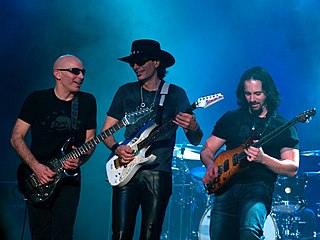
Shred guitar or shredding is a virtuoso style of playing the electric guitar, based on various advanced and complex playing techniques, particularly rapid passages and advanced performance effects. Shred guitar includes fast alternate picking, sweep-picked arpeggios, diminished and harmonic scales, finger-tapping and whammy bar use. It is commonly used in heavy metal, where guitarists use the electric guitar with a guitar amplifier and a range of electronic effects such as distortion, which create a more sustained guitar tone and facilitate guitar feedback effects.
Finger vibrato is vibrato produced on a string instrument by cyclic hand movements. Despite the name, normally the entire hand moves, and sometimes the entire upper arm. It can also refer to vibrato on some woodwind instruments, achieved by lowering one or more fingers over one of the uncovered holes in a trill-like manner. This flattens the note periodically creating the vibrato.
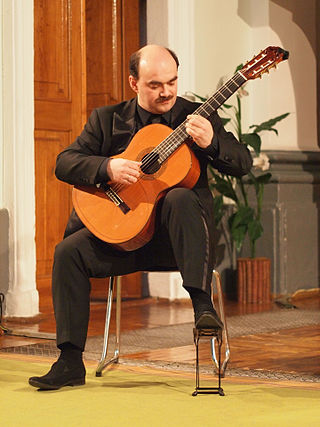
In classical guitar, the right hand is developed in such a way that it can sustain two, three, and four voice harmonies while also paying special attention to tone production. The index (i), middle (m), and ring (a) fingers are generally used to play the melody, while the thumb (p) accompanies in the bass register adding harmony and produces a comparable texture and effect to that of the piano. The classical guitar is a solo polyphonic instrument, and it is difficult to master.

A flamenco guitar is a guitar similar to a classical guitar but with thinner tops and less internal bracing. It usually has nylon strings, like the classical guitar, but it generally possesses a livelier, more gritty sound compared to the classical guitar. It is used in toque, the guitar-playing part of the art of flamenco.

A guitar synthesizer is any one of a number of musical instrument systems that allow a guitarist to access synthesizer capabilities.

Playing a string harmonic is a string instrument technique that uses the nodes of natural harmonics of a musical string to isolate overtones. Playing string harmonics produces high pitched tones, often compared in timbre to a whistle or flute. Overtones can be isolated "by lightly touching the string with the finger instead of pressing it down" against the fingerboard. For some instruments this is a fundamental technique, such as the Chinese guqin, where it is known as fan yin, and the Vietnamese đàn bầu.
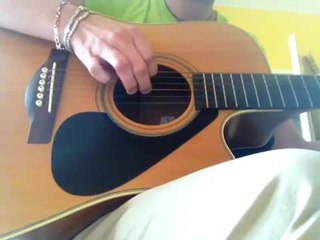
Guitar picking is a group of hand and finger techniques a guitarist uses to set guitar strings in motion to produce audible notes. These techniques involve plucking, strumming, brushing, etc. Picking can be done with:

A stoptail bridge used on a solid body electric guitar or archtop guitar is a specialized kind of fixed hard-tail bridge. Hard-tail bridged guitars use different bridges from those guitars fitted with vibrato systems.
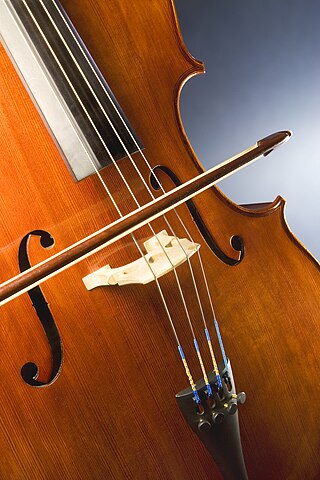
A bridge is a device that supports the strings on a stringed musical instrument and transmits the vibration of those strings to another structural component of the instrument—typically a soundboard, such as the top of a guitar or violin—which transfers the sound to the surrounding air. Depending on the instrument, the bridge may be made of carved wood, metal or other materials. The bridge supports the strings and holds them over the body of the instrument under tension.

This is a glossary of jazz and popular music terms that are likely to be encountered in printed popular music songbooks, fake books and vocal scores, big band scores, jazz, and rock concert reviews, and album liner notes. This glossary includes terms for musical instruments, playing or singing techniques, amplifiers, effects units, sound reinforcement equipment, and recording gear and techniques which are widely used in jazz and popular music. Most of the terms are in English, but in some cases, terms from other languages are encountered.

Heavy metal guitar is the use of highly-amplified electric guitar in heavy metal. Heavy metal guitar playing is rooted in the guitar playing styles developed in 1960s-era blues rock and psychedelic rock, and folk harmonic traditions and it uses a massive sound, characterized by highly amplified distortion, extended guitar solos and overall loudness. The electric guitar and the sonic power that it projects through amplification has historically been the key element in heavy metal. The heavy metal guitar sound comes from a combined use of high volumes and heavy distortion.
















